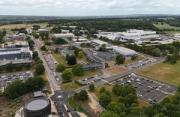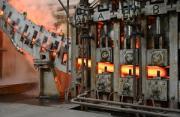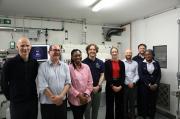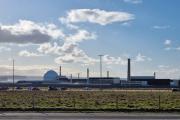Dounreay Bulletin - Issue 13
24th October 2006
GROUP PUBLISHES SOCIO ECONOMIC STRATEGY.
A working group chaired by John Thurso MP and comprising of key stakeholders in the economy around Dounreay has completed its work with the publication of a strategy for addressing the social and economic consequences of site closure. The MP for Caithenss, Sutherland and Easter Ross said: "Our remit was to create a strategy. This work is complete. The task now is to turn strategy into action and we have made a number of recommendations as to how that should happen. I would also like to thank all the members of the group for all the work they have done." See: http://www.ukaea.org.uk/sites/dounreay_and_the_economy.htm
�12 MILLION FOR ECONOMIC REGENERATION AROUND DOUNREAY
Highlands and Islands Enterprise announced on October 19 it is to invest an extra �12 million in Caithness and Sutherland. The extra funding, a 50 per cent increase on the current budget allocation for the area, will be used over the next three years to help address the considerable challenges posed to the area's economy by the decommissioning of Dounreay. (See: http://www.hie.co.uk/Default.aspx.LocID-0finewl4l.RefLocID-0fihiesv500b008.Lang-EN.htm)
CASE OPENS OFFICE AT SITE
Following HIE's announcement, a further initiative has been undertaken by its local enterprise company CASE in establishing a presence on-site at Dounreay. An office has been set aside, at Room 5 in D1300 where CASE staff will be available to meet with any individual who would like to call in for an informal chat about their future and to find out how best CASE may be able to provide support for their plans. The CASE office will be staffed by Charles Findlay and Keith Muir, two highly experienced business development professionals. Any discussion with CASE will be held in complete confidence. Initially the office will be open every Monday and Thursday from 10.00 am to 3.30 pm.
UPDATE ON MANPOWER REQUIREMENTS
UKAEA Dounreay has published updated figures about employment at the site and projections of reducing manpower needs as more of the fast reactor experiment is cleaned out and demolished. The report states that current employment levels of approximately 2,000 are expected to reduce by 500 over the next five years and upon completion of the decommissioning programme in 2033, employment will have reduced to 23.
UKAEA Dounreay acting site director Simon Middlemas said: "There are overwhelming safety, environmental and security reasons for completing the clean-up and demolition of the site as quickly as it is safe to do so. But I recognise that closure of the site and the inevitable loss of employment in decommissioning has major social and economic consequences. That is why UKAEA, supported by our business partners AMEC and CH2MHILL, welcomes today's announcement and will continue to work closely with Caithness and Sutherland Enterprise and other partners to support the regeneration of the area's economy." See: http://www.ukaea.org.uk/news/2006/19_10_06.html
SCOTTISH PARLIAMENT TO DEBATE CLOSURE
The Scottish Parliament is to be debate the social and economic consequences arising from the closure of Dounreay. A motion tabled by Jamie Stone, MSP for Caithness, Sutherland and Easter Ross, and due for debate on October 25, calls on the the Parliament to note "the severe economic and social challenges for the far north presented by the accelerated run-down and decommissioning at Dounreay and considers that the Scottish Executive should work with the UK Government and other key players to ensure that a costed and funded strategy is put in place as soon as possible so that suitable replacement industries and jobs can be established for the years to come".
PINHOLE REPAIR WILL AID DECOMMISSIONING OF FUEL PLANT
Operators at Dounreay have completed an extremely challenging repair in the disassembly cave of the fast reactor fuel reprocessing plant. The facility processed spent fuel rods from the prototype fast reactor (PFR) until 1996.
Irradiated fuel was received from PFR and reprocessed in a series of heavily shielded caves. The largest of these was the disassembly cave, where the fuel assemblies were dismantled and the fuel pins cropped, before being transferred to the dissolver cell for dissolving in nitric acid. More: http://www.ukaea.org.uk/sites/dounreay_project_updates.htm#Oct0601
UPDATE ON MAJOR NEW WASTE TREATMENT PLANT
During the last year, UKAEA has progressed significantly on the plans for a new plant to treat certain liquid and solid radioactive wastes that are a legacy of reprocessing fast reactor fuel at Dounreay. Subject to planning and other consents, construction of the waste treatment plant is expected to commence around early 2008 and is estimated to employ 120 workers during the construction phases. See: http://www.ukaea.org.uk/sites/dounreay_project_updates.htm#Oct0602
ABSORBERS RETURNED TO PFR
Four historical reactor components, originally sent to D8571 (part of the Dounreay Materials Test Reactor complex) in the late 1980s for examination, have now been returned to the Prototype Fast Reactor decommissioning team. The absorber sub-assemblies were used in PFR to control the rate of the nuclear reaction. Their return allows the DMTR decommissioning team to complete the first phase of post-operative clean out on the D8571 Post Irradiation Examination cave where the components had been stored.
The return of the absorber sub-assemblies to PFR also completes the reconciliation of all the remaining irradiated PFR absorbers. They will be dismantled and the absorber pins de-cladded in the irradiated fuel cell at PFR during 2007/08.
DOUNREAY SHARES SAFETY EXPERIENCE WITH LITHUANIAN CLEAN-UP TEAM
Dounreay has been sharing its expertise in the safe decommissioning of redundant nuclear facilities to assist the closure of the Ignalina nuclear power plant in Lithuania.
Ken Percival, of Dounreay 's assurance unit, travelled to Lithuania at the request of the International Atomic Energy Agency to support a workshop about decommissioning of the Ignalina reactor. The workshop focussed on practical experience in effective planning, health and safety management and radiation protection during decommissioning and was attended by about 20 Lithuanian nuclear industry personnel. One of the conditions for Lithuania's accession to the EU was the early decommissioning of its two RBMK reactors at Ignalina. Decommissioning will be largely funded by the EU, and since the NPP represents about 70% of the country's electricity requirements it poses significant technical and social challenges.
Related Businesses
Related Articles
UKAEA develops 3D printing for fusion components
At its recently opened Central Support Facility (CSF), UKAEA has commissioned an electron beam additive manufacturing machine that can be used to incorporate tungsten into components, alongside a selective laser manufacturing machine. Fusion can play a key role in a global low carbon energy future.Advancing Fusion Remote Maintenance: Industry Collaboration Driving Innovation
As part of the Fusion Futures (FF) programme, UKAEA's Remote Applications in Challenging Environments (RACE) has partnered with industry leaders to develop two groundbreaking technologies for remote maintenance in fusion energy engineering. Thanks to FF funding, industry has taken the lead in maturing UKAEA technology concepts—delivering real-world solutions that enhance operational autonomy and reduce maintenance burdens in extreme environments.UKAEA launches International Fellowships Scheme for fusion
UKAEA has launched the International Fellowships Scheme, an initiative to help expand the global talent pool supporting the fusion industry. The scheme is part of the UKAEA's Fusion Opportunities in Skills, Training, Education and Research (FOSTER) Programme, which aims to train, support, and empower the next generation of professionals, who will help deliver fusion power to the grid.Kyoto Fusioneering and Astral Systems join Culham fusion hub
UKAEA's Culham Campus welcomes Kyoto Fusioneering and Astral Systems as its latest tenants. Two pioneering companies, Kyoto Fusioneering and Astral Systems, have joined the growing cluster of fusion technology and AI organisations at United Kingdom Atomic Energy Authority's (UKAEA) Culham Campus.
Fusion-grade Steel Produced At Scale In UK-first
Researchers achieve 10x production cost savings for reduced activation steel. A United Kingdom Atomic Energy Authority (UKAEA) working group has successfully demonstrated the industrial scale production of fusion-grade steel.
UKAEA To Lead The Creation Of A Robotics And AI Cluster
UKAEA will lead the creation of a new £4.9m nuclear robotics and artificial intelligence cluster across Cumbria and Oxfordshire. The robotics and AI cluster was announced by UK Research and Innovation (UKRI) as one of seven new projects to kickstart economic growth and address regional needs: www.ukri.org The robotics and AI cluster will link Cumbria and Oxfordshire to accelerate the decommissioning of the UK's legacy nuclear fission facilities and keep people out of hazardous environments.
Diamonds Are Forever? World-first Carbon-14 Diamond Battery Made In Uk
The world's first carbon-14 diamond has been produced with the potential to provide power for thousands of years. Scientists and engineers from the UK Atomic Energy Authority (UKAEA) and the University of Bristol have successfully created the world's first carbon-14 diamond battery.
UKAEA Monthly Newsletter Latest Edition
Find out what has been happening at UKAEA in our monthly newsletter. Read about our recent activities and upcoming events.
UKAEA Newsletter - Edition 11 Published Today
Find out what has been happening at UKAEA in our monthly newsletter. Read about our recent activities and upcoming events.
Corwm Visits Dounreay Nuclear Site
Members were given an overview of the scale of the problem and challenges faced in the decommissioning of the site. In the last week of March 2024, several members of CoRWM led by the Chair, Sir Nigel Thrift, made the long journey up to the North of Scotland to visit the Dounreay nuclear site, now managed by Nuclear Restoration Services.
